Our Galaxy
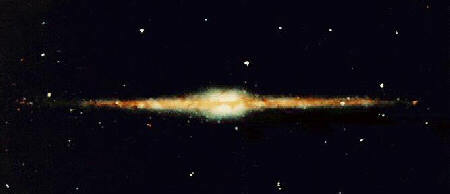
Our Galaxy in Infrared Light
This image of our galaxy, the Milky Way, was taken with NASA's Cosmic Background Explorer (COBE)'s Diffuse Infrared Background Experiment (DIRBE), one of three COBE scientific instruments. This never-before-seen view is a combination of data gathered with DIRBE at intervals within the first six months in orbit and released in April 1990.
It shows the Milky Way from an edge-on perspective with the galactic north pole at the top, south pole at the bottom and galactic center at the center. The picture combines images obtained at several near-infrared wavelengths. The dominant source of light at these wavelengths is stars within our galaxy. Even though our solar system is part of the Milky Way, the view looks distant because most of the light comes from the population of stars that are closer to the galactic center than our own Sun.

Ghostly Reflections in the Pleiades
Acknowledgement: George Herbig and Theodore Simon (Institute for Astronomy, University of Hawaii)
NASA's Hubble Space Telescope has caught the eerie, wispy tendrils of a dark interstellar cloud being destroyed by the passage of one of the brightest stars in the Pleiades star cluster. Like a flashlight beam shining off the wall of a cave, the star is reflecting light off the surface of pitch black clouds of cold gas laced with dust. These are called reflection nebulae.
The famous cluster is easily visible in the evening sky during the winter months as a small grouping of bright blue stars, named after the "Seven Sisters" of Greek mythology. Resembling a small dipper, this star cluster lies in the constellation Taurus at a distance of about 380 light-years from Earth. The unaided eye can discern about half a dozen bright stars in the cluster, but a small telescope will reveal that the Pleiades contains many hundreds of fainter stars.
In many cases, the nebulae surrounding star clusters represent material from which the stars have formed recently. However the Pleiades nebulosity is actually an independent cloud, drifting through the cluster at a relative speed of about 6.8 miles/second (11 kilometers/second).
In 1890, American astronomer E. E. Barnard, observing visually with the Lick Observatory 36-inch telescope in California, discovered an exceptionally bright nebulosity adjacent to the bright Pleiades star Merope. It is now cataloged as IC 349, or "Barnard's Merope Nebula." IC 349 is so bright because it lies extremely close to Merope--only about 3,500 times the separation of the Earth from the Sun, or about 0.06 light-year--and thus is strongly illuminated by the star's light.
In the new Hubble image, Merope itself is just outside the frame on the upper right. The colorful rays of light at the upper right, pointing back to the star, are an optical phenomenon produced within the telescope, and are not real. However, the remarkable parallel wisps extending from lower left to upper right are real features, revealed for the first time through Hubble's high-resolution imaging capability. Astronomers George Herbig and Theodore Simon of the University of Hawaii obtained these broadband observations with Hubble’s Wide Field and Planetary Camera 2 on September 19, 1999.
Herbig and Simon propose that, as the Merope Nebula approaches Merope, the strong starlight shining on the dust decelerates the dust particles. Physicists call this phenomenon "radiation pressure."
Smaller dust particles are slowed down more by the radiation pressure than the larger particles. Thus, as the cloud approaches the star, there is a sifting of particles by size, much like grain thrown in the air to separate wheat from chaff. The nearly straight lines pointing toward Merope are thus streams of larger particles, continuing on toward the star while the smaller decelerated particles are left behind at the lower left of the picture.
Over the next few thousand years, the nebula--if it survives the close passage without being completely destroyed--will move on past Merope, somewhat like a comet swinging past our Sun. This chance collision allows astronomers to study interstellar material under very rare conditions, and thus learn more about the structure of the dust lying between the stars.

Close-up View of a Reflection Nebula in Orion
Just weeks after NASA astronauts repaired the Hubble Space Telescope in December 1999, the Hubble Heritage Project snapped this picture of NGC 1999, a nebula in the constellation Orion. The Heritage astronomers, in collaboration with scientists in Texas and Ireland, used Hubble's Wide Field Planetary Camera 2 (WFPC2) to obtain the color image.
NGC 1999 is an example of a reflection nebula. Like fog around a street lamp, a reflection nebula shines only because the light from an embedded source illuminates its dust; the nebula does not emit any visible light of its own. NGC 1999 lies close to the famous Orion Nebula, about 1,500 light-years from Earth, in a region of our Milky Way galaxy where new stars are being formed actively. The nebula is famous in astronomical history because the first Herbig-Haro object was discovered immediately adjacent to it (it lies just outside the new Hubble image). Herbig-Haro objects are now known to be jets of gas ejected from very young stars.
The NGC 1999 nebula is illuminated by a bright, recently formed star, visible in the Hubble photo just to the left of center. This star is cataloged as V380 Orionis, and its white color is due to its high surface temperature of about 10,000 degrees Celsius (nearly twice that of our own Sun). Its mass is estimated to be 3.5 times that of the Sun. The star is so young that it is still surrounded by a cloud of material left over from its formation, here seen as the NGC 1999 reflection nebula.
The WFPC2 image of NGC 1999 shows a remarkable jet-black cloud near its center, resembling a letter T tilted on its side, located just to the right and lower right of the bright star. This dark cloud is an example of a "Bok globule," named after the late University of Arizona astronomer Bart Bok. The globule is a cold cloud of gas, molecules, and cosmic dust, which is so dense it blocks all of the light behind it. In the Hubble image, the globule is seen silhouetted against the reflection nebula illuminated by V380 Orionis. Astronomers believe that new stars may be forming inside Bok globules, through the contraction of the dust and molecular gas under their own gravity.
NGC 1999 was discovered some two centuries ago by Sir William Herschel and his sister Caroline, and was cataloged later in the 19th century as object 1999 in the New General Catalogue.
These data were collected in January 2000 by the Hubble Heritage Team with the collaboration of star-formation experts C. Robert O'Dell (Rice University), Thomas P. Ray (Dublin Institute for Advanced Study), and David Corcoran (University of Limerick).

A Crucible of Creation:
Hubble's Panoramic Mosaic of the Orion Nebula

This spectacular color panorama of the center the Orion nebula is one of the largest pictures ever assembled from individual images taken with NASA's Hubble Space Telescope. The picture, seamlessly composited from a mosaic of 15 separate fields, covers an area of sky about five percent the area covered by the full Moon.
The seemingly infinite tapestry of rich detail revealed by Hubble shows a churning turbulent star factory set within a maelstrom of flowing, luminescent gas. Though this 2.5 light-years wide view is still a small portion of the entire nebula, it includes almost all of the light from the bright glowing clouds of gas and a star cluster associated with the nebula. Hubble reveals details as small as 4.1 billion miles across.
Hubble Space Telescope observing time was devoted to making this panorama because the nebula is a vast laboratory for studying the processes which gave birth to our own Sun and solar system 4.5 billion years ago. Many of the nebula's details can't be captured in a single picture - any more than one snapshot of the Grand Canyon yields clues to its formation and history. Like the Grand Canyon, the Orion nebula has a dramatic surface topography -- of glowing gasses instead of rock -- with peaks, valleys and walls. They are illuminated and heated by a torrent of energetic ultraviolet light from its four hottest and most massive stars, called the Trapezium, which lie near the center of the image.
In addition to the Trapezium, this stellar cavern contains 700 hundred other young stars at various stages of formation. High-speed jets of hot gas spewed by some of the infant stars send supersonic shock waves tearing into the nebula at 100,000 miles per hour. These shock waves appear as thin curved loops, sometimes with bright knots on their end (the brightest examples are near the bright star at the lower left).
The mosaic reveals at least 153 glowing protoplanetary disks (first discovered with the Hubble in 1992, and dubbed "proplyds") that are believed to be embryonic solar systems that will eventually form planets. (Our solar system has long been considered the relic of just such a disk that formed around the newborn Sun). The abundance of such objects in the Orion nebula strengthens the argument that planet formation is a common occurrence in the universe. The proplyds that are closest to the Trapezium stars (image center) are shedding some of their gas and dust. The pressure of starlight from the hottest stars forms "tails" which act like wind vanes pointing away from the Trapezium. These tails result from the light from the star pushing the dust and gas away from the outside layers of the proplyds. In addition to the luminescent proplyds, seven disks are silhouetted against the bright background of the nebula. These dark objects allow Hubble astronomers to estimate the masses of the disks as at least 0.1 to 730 times the mass of our Earth.
Located 1,500 light-years away, along our spiral arm of the Milky Way, the Orion nebula is located in the middle of the sword region of the constellation Orion the Hunter, which dominates the early winter evening sky, at northern latitudes. The stars have formed from collapsing clouds of interstellar gas within the last million years. The most massive clouds have formed the brightest stars near the center and these are so hot that they illuminate the gas left behind after the period of star formation was complete. The more numerous faint stars are still in the process of collapsing under their own gravity, but have become hot enough in their centers to be self luminous bodies.
45 separate images of the Orion nebula were taken in blue, green and red between January 1994 and March 1995. Light emitted by oxygen is shown as blue, hydrogen emission is shown as green, and nitrogen emission as red light. The overall color balance is close to that which an observer living near the Orion nebula would see. The irregular borders produced by the HST images have been smoothed out by the addition of images from the European Southern Observatory in Chile obtained by Bo Reipurth and John Bally.
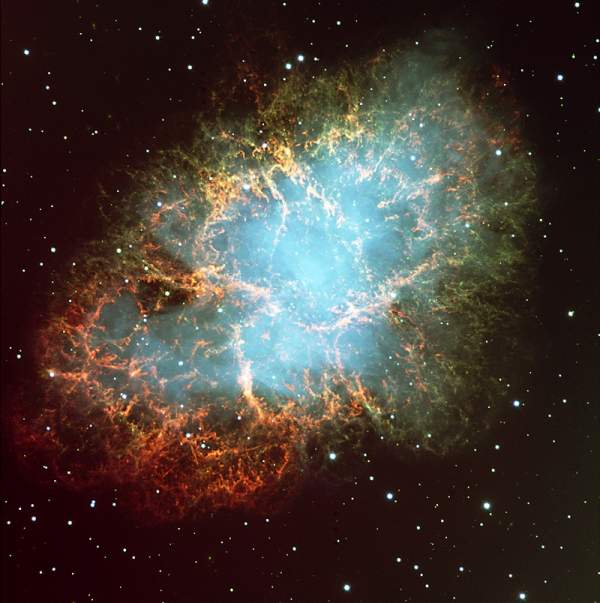
M1, The Crab Nebula
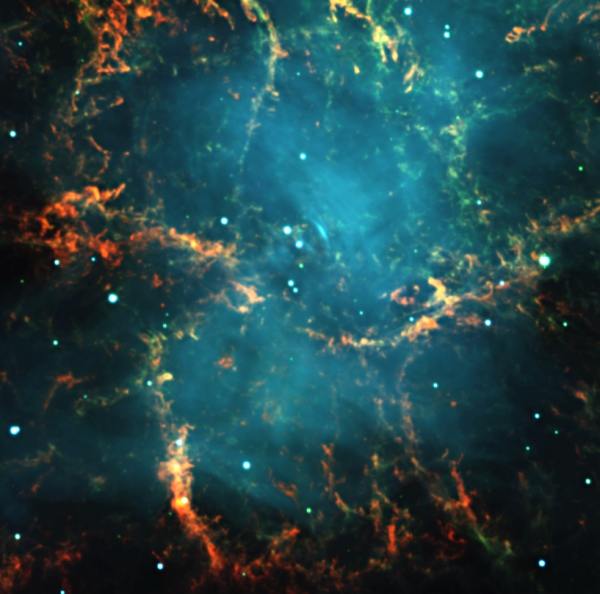
These photos show a three color composite of the well-known Crab Nebula (also known as Messier 1), as observed with the FORS2 instrument in imaging mode in the morning of November 10, 1999. It is the remnant of a supernova explosion at a distance of about 6,000 light-years, observed almost 1000 years ago, in the year 1054. It contains a neutron star near its center that spins 30 times per second around its axis.
The green light is predominantly produced by hydrogen emission from material ejected by the star that exploded. The blue light is predominantly emitted by very high-energy ("relativistic") electrons that spiral in a large-scale magnetic field (so-called syncrotron emission). It is believed that these electrons are continuously accelerated and ejected by the rapidly spinning neutron star at the center of the nebula and which is the remnant core of the exploded star. This pulsar has been identified with the lower/right of the two close stars near the geometric center of the nebula, immediately left of the small arc-like feature, best seen in the lower photo.
Technical information: Photos are based on a composite of three images taken through three different optical filters: B (429 nm; FWHM 88 nm; 5 min; here rendered as blue), R (657 nm; FWHM 150 nm; 1 min; green) and S II (673 nm; FWHM 6 nm; 5 min; red) during periods of 0.65 arcsec (R, S II) and 0.80 (B) seeing, respectively. The field shown in the above photo measures 6.8 x 6.8 arcmin and the three separate images were recorded in frames of 2048 x 2048 pixels, each measuring 0.2 arcsec. North is up; East is left.

Hubble Captures Dynamics of the Crab Nebula
A new sequence of Hubble Space Telescope images of the remnant of a tremendous stellar explosion is giving astronomers a remarkable look at the dynamic relationship between the tiny Crab Pulsar and the vast nebula that it powers.
The colorful photo at the right shows a ground-based (Palimar Observatory) image of the entire Crab Nebula, the remnant of a supernova explosion witnessed over 900 years ago. The nebula, which is 10 light-years across, is located 7,000 light-years away in the constellation Taurus. The green, yellow and red filaments concentrated toward the edges of the nebula are remnants of the star that were ejected into space by the explosion.
At the center of the Crab Nebula lies the Crab Pulsar -- the collapsed core of the exploded star. The Crab Pulsar is a rapidly rotating neutron star -- an object only about six miles across, but containing more mass than our Sun. As it rotates at a rate of 30 times per second the Crab Pulsar's powerful magnetic field sweeps around, accelerating particles, and whipping them out into the nebula at speeds close to that of light.
The blue glow in the inner part of the nebula -- light emitted by energetic electrons as they spiral through the Crab's magnetic field -- is powered by the Crab Pulsar.

The picture on the left shows a Hubble Space Telescope image of the inner parts of the Crab. The pulsar itself is visible as the left of the pair of stars near the center of the frame. Surrounding the pulsar is a complex of sharp knots and wisp-like features. This image is one of a sequence of Hubble images taken over the course of several months. This sequence shows that the inner part of the Crab Nebula is far more dynamic than previously understood. The Crab literally "changes it stripes" every few days as these wisps stream away from the pulsar at half the speed of light.
The Hubble Space Telescope photo was taken Nov. 5, 1995 by the Wide Field and Planetary Camera 2 at a wavelength of around 550 nanometers, in the middle of the visible part of the electromagnetic spectrum.

Gaseous Pillars of Creation in M16
These eerie, dark pillar-like structures are actually columns of cool interstellar hydrogen gas and dust that are also incubators for new stars. The pillars protrude from the interior wall of a dark molecular cloud like stalagmites from the floor of a cavern. They are part of the "Eagle Nebula" (also called M16 -- the 16th object in Charles Messier's 18th century catalog of "fuzzy" objects that aren't comets), a nearby star-forming region 7,000 light-years away in the constellation Serpens.
The pillars are in some ways akin to buttes in the desert, where basalt and other dense rock have protected a region from erosion, while the surrounding landscape has been worn away over millennia. In this celestial case, it is especially dense clouds of molecular hydrogen gas (two atoms of hydrogen in each molecule) and dust that have survived longer than their surroundings in the face of a flood of ultraviolet light from hot, massive newborn stars (off the top edge of the picture). This process is called "photoevaporation. "This ultraviolet light is also responsible for illuminating the convoluted surfaces of the columns and the ghostly streamers of gas boiling away from their surfaces, producing the dramatic visual effects that highlight the three-dimensional nature of the clouds. The tallest pillar (left) is about a light-year long from base to tip.
As the pillars themselves are slowly eroded away by the ultraviolet light, small globules of even denser gas buried within the pillars are uncovered. These globules have been dubbed "EGGs." EGGs is an acronym for "Evaporating Gaseous Globules," but it is also a word that describes what these objects are. Forming inside at least some of the EGGs are embryonic stars -- stars that abruptly stop growing when the EGGs are uncovered and they are separated from the larger reservoir of gas from which they were drawing mass. Eventually, the stars themselves emerge from the EGGs as the EGGs themselves succumb to photoevaporation.
The picture was taken on April 1, 1995 with the Hubble Space Telescope Wide Field and Planetary Camera 2. The color image is constructed from three separate images taken in the light of emission from different types of atoms. Red shows emission from singly-ionized sulfur atoms. Green shows emission from hydrogen. Blue shows light emitted by doubly-ionized oxygen atoms.

The Horsehead Nebula
Acknowledgment: K. Noll (Hubble Heritage PI/STScI), C. Luginbuhl (USNO), F. Hamilton (Hubble Heritage/STScI)
Rising from a sea of dust and gas like a giant seahorse, the Horsehead nebula is one of the most photographed objects in the sky. NASA's Hubble Space Telescope took a close-up look at this heavenly icon, revealing the cloud's intricate structure. This detailed view of the horse's head is being released to celebrate the orbiting observatory's eleventh anniversary. Produced by the Hubble Heritage Project, this picture is a testament to the Horsehead's popularity. Internet voters selected this object for the orbiting telescope to view.
The Horsehead, also known as Barnard 33, is a cold, dark cloud of gas and dust, silhouetted against the bright nebula, IC 434. The bright area at the top left edge is a young star still embedded in its nursery of gas and dust. But radiation from this hot star is eroding the stellar nursery. The top of the nebula also is being sculpted by radiation from a massive star located out of Hubble's field of view.
Only by chance does the nebula roughly resemble the head of a horse. Its unusual shape was first discovered on a photographic plate in the late 1800s. Located in the constellation Orion, the Horsehead is a cousin of the famous pillars of dust and gas known as the Eagle nebula. Both tower-like nebulas are cocoons of young stars.
The Horsehead nebula lies just south of the bright star Zeta Orionis, which is easily visible to the unaided eye as the left-hand star in the line of three that form Orion's Belt. Amateur astronomers often use the Horsehead as a test of their observing skills; it is known as one of the more difficult objects to see visually in an amateur-sized telescope.
The magnificent extent of the Horsehead is best appreciated in a new wide-field image of the nebula being released today by the National Optical Astronomy Observatory, taken by Travis Rector with the National Science Foundation's 0.9-meter telescope at Kitt Peak National Observatory near Tucson, AZ.
This popular celestial target was the clear winner among more than 5,000 Internet voters, who were asked last year to select an astronomical target for the Hubble telescope to observe. The voters included students, teachers, and professional and amateur astronomers.
This 11th anniversary release image was composed by the Hubble Heritage Team, which superimposed Hubble data onto ground-based data (limited to small triangular regions around the outer edge of the image). Ground-based image courtesy of Nigel A. Sharp (NOAO/AURA/NSF) taken at the 0.9-meter telescope on Kitt Peak.
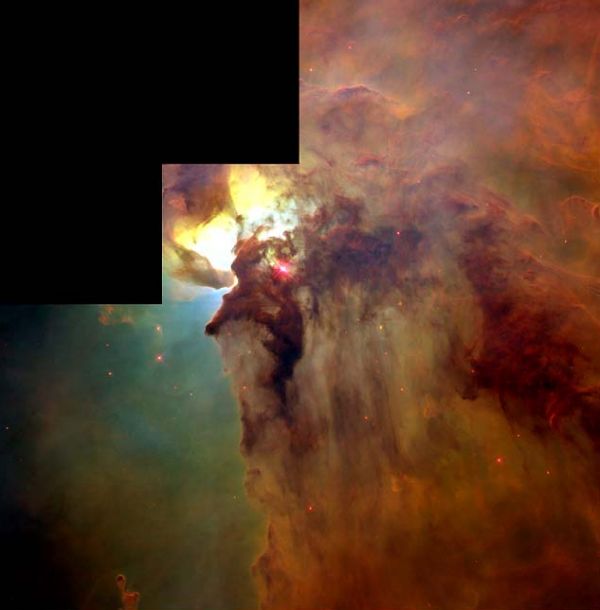
Giant "Twisters" in M8, The Lagoon Nebula

These NASA Hubble Space Telescope (HST) images reveal a pair of one-half light-year long interstellar "twisters" -- eerie funnels and twisted-rope structures -- in the heart of the Lagoon Nebula (Messier 8) which lies 5,000 light-years away in the direction of the constellation Sagittarius.
The central hot star, O Herschel 36 (upper left in left photo, lower right in right photo), is the primary source of the ionizing radiation for the brightest region in the nebula, called the Hourglass. Other hot stars, also present in the nebula, are ionizing the extended optical nebulosity. The ionizing radiation induces photo-evaporation of the surfaces of the clouds (seen as a blue "mist" at the right of the left image), and drives away violent stellar winds tearing into the cool clouds.
Analogous to the spectacular phenomena of Earth tornadoes, the large difference in temperature between the hot surface and cold interior of the clouds, combined with the pressure of starlight, may produce strong horizontal shear to twist the clouds into their tornado-like appearance. Though the spiral shapes suggest the clouds are "twisting", future observations will be needed, perhaps with Hubble's next generation instruments, with the spectroscopic capabilities of the Space Telescope Imaging Spectrograph (STIS) or the Near Infrared Camera and Multi-Object Spectrometer (NICMOS), to actually measure velocities.
The lower Hubble picture reveals a variety of small scale structures in the interstellar medium, small dark clouds called Bok globules, bow shocks around stars, ionized wisps, rings, knots and jets.
The Lagoon Nebula and nebulae in other galaxies are sites where new stars are being born from dusty molecular clouds. These regions are the "space laboratories" for the astronomers to study how stars form and the interactions between the winds from stars and the gas nearby. By studying the wealth of data revealed by HST, astronomers will understand better how stars form in the nebulae.
These color-coded images are the combination of individual exposures taken in July and September, 1995 with Hubble's Wide Field and Planetary Camera 2 (WFPC2) through three narrow-band filters (red light -- ionized sulphur atoms, blue light -- double ionized oxygen atoms, green light -- ionized hydrogen).
This work is based on public data retrieved from the HST Archive, cosmic-ray cleaned, calibrated and combined by Adeline Caulet (Space Telescope European Coordinating Facility, European Space Agency).
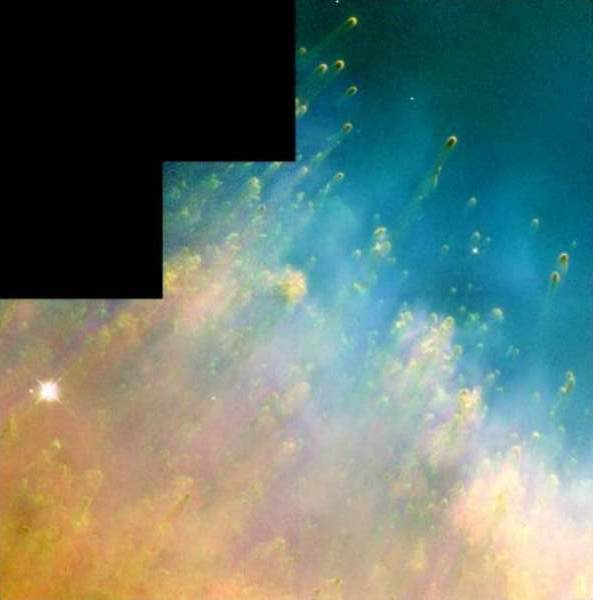
A Close-up of the Helix Nebula
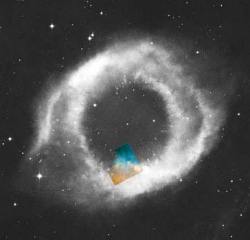
This colorful image from the Hubble Space Telescope shows the collision of two gases near a dying star. Astronomers have dubbed the tadpole-like objects in the upper right-hand corner "cometary knots" because their glowing heads and gossamer tails resemble comets. Although astronomers have seen gaseous knots through ground-based telescopes, they have never seen so many in a single nebula.
Hubble captured thousands of these knots from a doomed star in the Helix nebula (NGC 7293), the closest planetary nebula to Earth at 450 light-years away in the constellation Aquarius. Each gaseous head is at least twice the size of our solar system; each tail stretches 100 billion miles, about 1,000 times the Earth's distance to the Sun. The most visible gaseous fragments lie along the inner edge of the star's ring, trillions of miles from the star at its center. The comet-like tails form a radial pattern around the star like the spokes on a wagon wheel. Astronomers have seen the spoke pattern using ground-based telescopes, but Hubble reveals for the first time the sources of these objects.
Astronomers theorize that the gaseous knots are the results of a collision between gases. The doomed star spews the hot gas from its surface, which collides with the cooler gas that it had ejected 10,000 years before. The crash fragments the smooth cloud surrounding the star into smaller, denser finger-like droplets, like dripping paint. Astronomers expect the gaseous knots, each several billion miles across, to eventually dissipate into the cold blackness of interstellar space.
This image was taken in August, 1994 with Hubble's Wide Field Planetary Camera 2. The red light depicts nitrogen emission ([NII] 6584A); green, hydrogen (H-alpha, 6563A); and blue, oxygen (5007A).
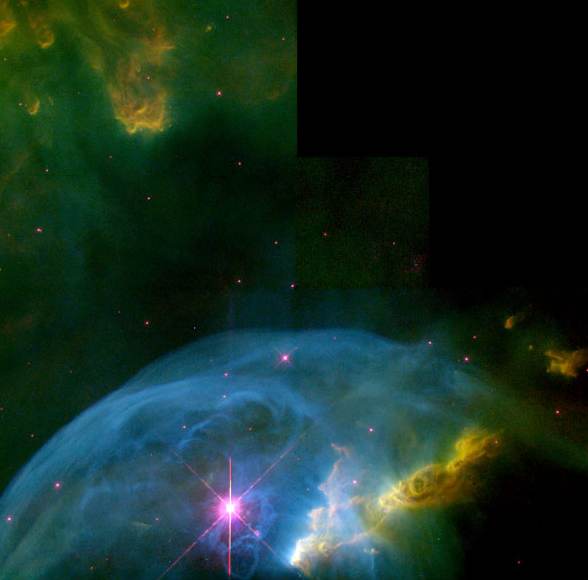
NGC7635, The Bubble Nebula
Astronomers, using the Wide Field Planetary Camera 2 on board NASA's Hubble Space Telescope in October and November 1997 and April 1999, imaged the Bubble Nebula (NGC 7635) with unprecedented clarity. For the first time, they are able to understand the geometry and dynamics of this very complicated system. Earlier pictures taken of the nebula with the Wide Field Planetary Camera 1 left many issues unanswered, as the data could not be fully calibrated for scientific use. In addition, those data never imaged the enigmatic inner structure presented here.
The remarkably spherical "Bubble" marks the boundary between an intense wind of particles from the star and the more quiescent interior of the nebula. The central star of the nebula is 40 times more massive than the Sun and is responsible for a stellar wind moving at 2,000 kilometers per second (4 million miles per hour or 7 million kilometers per hour) which propels particles off the surface of the star. The bubble surface actually marks the leading edge of this wind's gust front, which is slowing as it plows into the denser surrounding material. The surface of the bubble is not uniform because as the shell expands outward it encounters regions of the cold gas, which are of different density and therefore arrest the expansion by differing amounts, resulting in the rippled appearance. It is this gradient of background material that the wind is encountering that places the central star off center in the bubble. There is more material to the northeast of the nebula than to the southwest, so that the wind progresses less in that direction, offsetting the central star from the geometric center of the bubble. At a distance of 7,100 light-years from Earth, the Bubble Nebula is located in the constellation Cassiopeia and has a diameter of 6 light-years.
To the right of the central star is a ridge of much denser gas. The lower left portion of this ridge is closest to the star and so is brightest. It is experiencing the most intense ultraviolet radiation as well as the strong wind and is therefore being photoevaporated the fastest. The ridge forms a V-shape in the image, with two segments that are aligned at the brightest edge. The upper of these two segments is viewed quite obliquely as it trails off into the back of the nebula. The lower segment comes both toward the observer and off to the side. This lower ridge appears to lie within the sphere described by the bubble but is not actually "inside" the shocked region of gas. Instead it is being pushed up against the bubble like a hand being pushed against the outside of a party balloon. While the edge of the hand appears to be inside the balloon, it is not. As the bubble moves up but not through the ridge, bright blue arcs form where the supersonic wind strikes the ridge to form an apparent series of nested shock fronts.
The region between the star and ridge reveals several loops and arcs which have never been seen before. The high resolution capabilities of Hubble make it possible to examine these features in detail in a way that is not possible from the ground. The origin of this bubble-within-a-bubble" is unknown at this time. It may be due to a collision of two distinct winds. The stellar wind may be colliding with material streaming off the ridge as it is photoevaporated by the star's radiation.
Located at the top of the picture are dense clumps or fingers of molecular gas which have not yet encountered the expanding shell. These structures are similar in form to the columns in the Eagle Nebula, except that they are not being eroded as energetically as they are in that nebula. As in the Eagle, the clumps are seen to emit light because they are being illuminated by the strong ultraviolet radiation from the central star, which travels much faster than the shell and has reached the outer knots long before the expanding rim will.
Research Team: Donald Walter (South Carolina State University), Paul Scowen, Jeff Hester, Brian Moore (Arizona State University), Reggie Dufour, Patrick Hartigan and Brent Buckalew (Rice University).
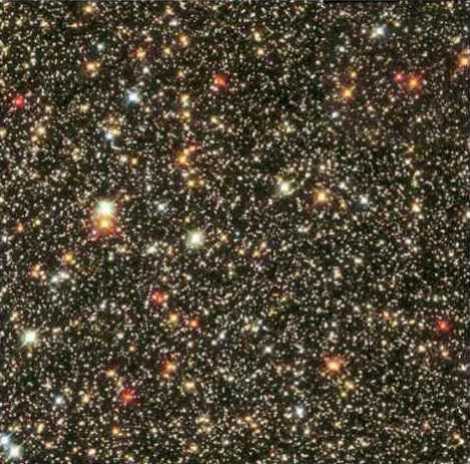
A Sky Full of Glittering Jewels
NASA's Hubble Space Telescope has given us a keyhole view towards the heart of our Milky Way Galaxy, where a dazzling array of stars reside. Most of the view of our galaxy is obscured by dust. Hubble peered into the Sagittarius Star Cloud, a narrow, dust-free region, providing this spectacular glimpse of a treasure chest full of stars. Some of these gems are among the oldest inhabitants of our galaxy. By studying the older stars that pack our Milky Way's hub, scientists can learn more about the evolution of our galaxy.
Many of the brighter stars in this image show vivid colors. A star's color reveals its temperature, one of its most "vital statistics." Knowing a star's temperature and the power of the star's radiation allow scientists to make conclusions about its age and mass. Most blue stars are young and hot, up to ten times hotter than our Sun. They consume their fuel much faster and live shorter lives than our Sun. Red stars come in two flavors: small stars and "red giants". Smaller red stars generally have a temperature about half that of our Sun, consuming their fuel slowly and thus, live the longest. "Red giant" stars are at the end of their lives because they have exhausted their fuel. Although many "red giant" stars may have been ordinary stars like our Sun, as they die they swell up in size, become much cooler, and are much more luminous then they were during the majority of their stellar life.
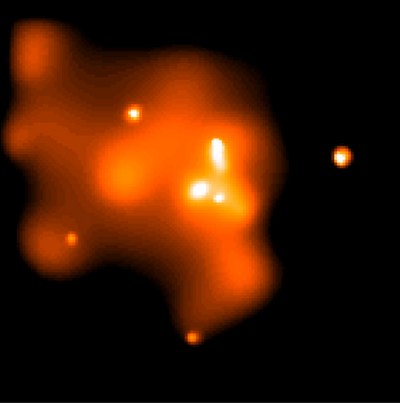
X-ray Source At The Center Of Our Galaxy
The orbiting Chandra X-ray Telescope imaged the innermost 10 light years at the center of our galaxy.
The image has been smoothed to bring out the X-ray emission from an extended cloud of hot gas surrounding the supermassive black-hole candidate Sagittarius A* (larger white dot at the very center of the image - a little to the left and above the smallest white dot). This gas glows in X-ray light because it has been heated to a temperature of millions of degrees by shock waves produced by supernova explosions and perhaps by colliding winds from young massive stars.
Image made with the Advanced CCD Imaging Spectrometer (ACIS)
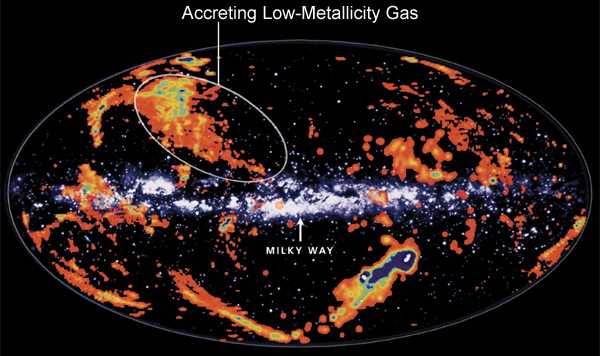
Gas Clouds Raining Star Stuff onto the Milky Way Galaxy
The background Milky Way image is a drawing made at Lund Observatory. High-velocity clouds are from the survey done at Dwingeloo Observatory (Hulsbosch & Wakker, 1988).
This composite radio light image and rendition of our galaxy as seen in visible light shows enigmatic "high-velocity clouds" of gas high above the plane of the Milky Way which rain gas into the galaxy, seeding it with the stuff of stars.
The cloud outlined, and possibly others too, is now known to have low heavy element content and to be raining down onto the Milky Way disk, seeding it with material for star birth. Identifying this infalling gas helps in solving a long-standing mystery of galactic evolution by revealing a source of the low-metallicity gas required to explain the observed chemical composition of stars near the Sun.
In this all-sky projection, the edge-on plane of our galaxy appears as a white horizontal strip. The false-color orange-yellow "clouds" are regions containing neutral hydrogen, which glows in 21-centimeter radiation. Hubble Space Telescope's spectrograph was aimed at one of the clouds (encircled) to measure its detailed composition and velocity.
This discovery is based on a combination of data from NASA's Hubble Space Telescope, three radio telescopes (at Effelsberg in Germany, and Dwingeloo and Westerbork in the Netherlands), the William Herschel Telescope on the island of La Palma and the Wisconsin H-alpha Mapper at NOAO's Kitt Peak Observatory.
 CosmicLight.com Home
CosmicLight.com Home